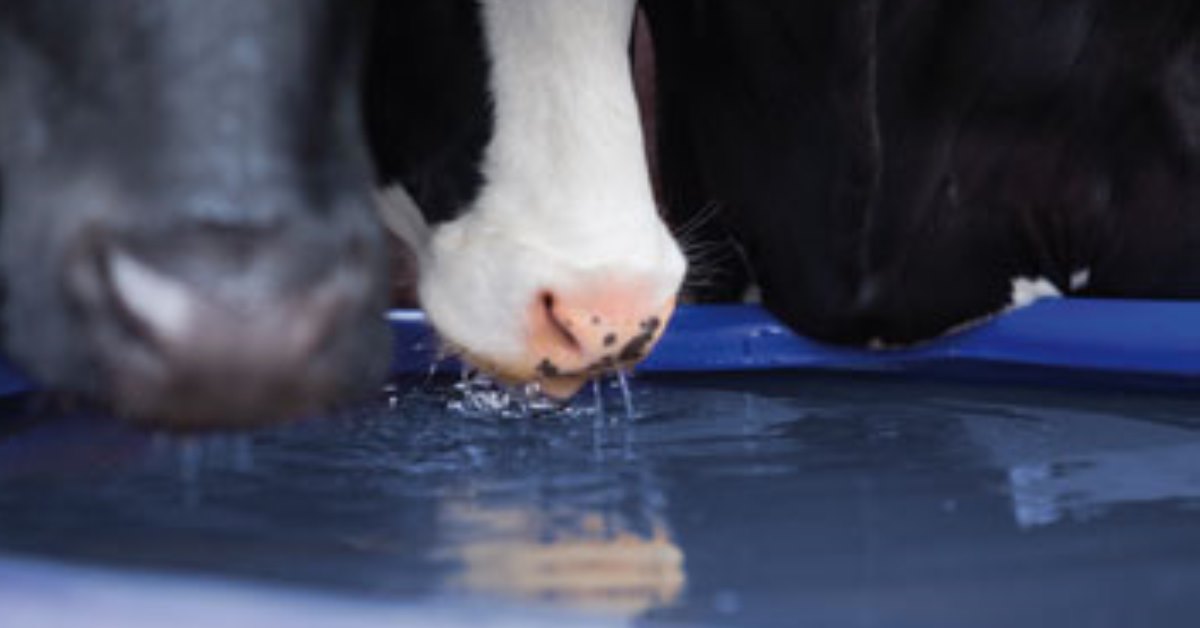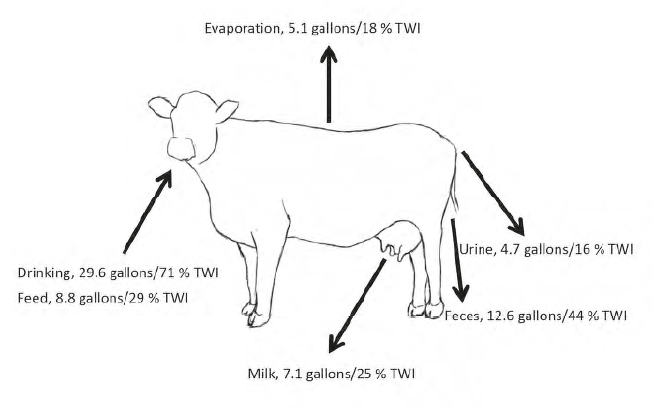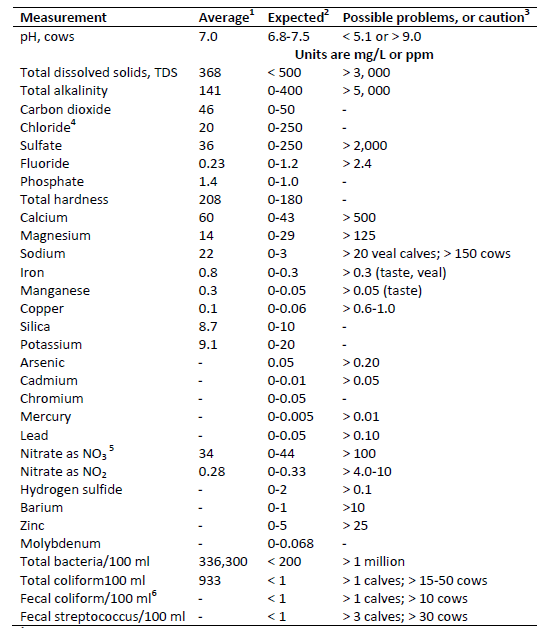
Water is an essential nutrient. When ranking the elements needed for nourishment, water follows only oxygen in importance. However, many times water quality gets overlooked and does not receive the attention that other aspects of the ration receive.
Lactating dairy cattle require a substantial amount of water because a significant amount of water is secreted within milk. Restriction in free water intake can lead to significant losses in milk production. Many factors can impact free water intake. Feed consumption, sodium and potassium content of the diet, increased humidity and environmental temperatures can all play a role.
Approximately 71 percent of the total water intake of the cow comes from drinking water, while the remaining 29 percent comes from feed. The greatest amount of water is lost through the feces, followed by milk production and excretion through the urine (Figure 1). In times of heat stress, a significant portion of water is also lost through evaporation.
How minerals impact water quality
Sulfates found in water include calcium, iron, magnesium, manganese and sodium salts. They originate from sulfate-bearing minerals in the ground. The biggest concern with sulfates has to do with the rumen, where the sulfur coming from salts will be reduced to sulfide, with the potential to tie up trace minerals such as copper and selenium, making them unavailable to the cow.
The iron found within water is usually in the ferrous (Fe2+) form as opposed to the ferric (Fe3+) form. High concentrations of iron in the water may cause negative interactions with other minerals such as copper and zinc, making them less readily available to the cow. Another potential concern with iron is the potential for it to contribute to oxidative stress, resulting in animals with weakened immune systems, such as in the periparturient cow, which is more susceptible to disease.
Nitrates are also of concern in water. Animals require neither nitrate (NO3-) nor nitrite (NO2-), so nitrate poisoning through the consumption of feed or water can occur. And, because of how ruminants break down nitrates within the rumen, they are even more susceptible to poisoning.
Keep an eye on your water supply
Water is not only a valuable source of nutrients, but significantly impacts the daily intake of minerals. Additionally, water is required for regulation of digestion and metabolic processes. Therefore, water quality is of utmost importance. High-quality water is generally clear and odorless. However, water can contain many contaminants that are less easy to spot.
Pollutants, dangerous microorganisms and some minerals (as mentioned above) can affect the production and health of the cow. To check for contaminants, water quality should be evaluated several times a year for coliforms, proper pH levels, minerals, nitrates and nitrites, and total bacteria.
When evaluating water, consider the following:
- In comparison to mineral estimates from human drinking water, estimates may seem conservative when applied to livestock.
- The chemical form of minerals greatly affects reactivity and toxicity, and many reports only focus on total concentration and not on chemical form.

Figure 1. Flow of water, gallons/day or as a percentage of total water intake (TWI), estimated in cows consuming 47 pounds of dry matter and producing 68 pounds of milk that contained 3.96 percent fat and 3 percent protein (Khelil-Arfa et al., 2014).
Table 1 shows concentrations of analytes in drinking water and expected ranges and thresholds. Total dissolved solids refers to the inorganic substituents dissolved in fresh water. It also indicates salinity of the water. Typically, heifers and dry cows can handle greater concentrations of salinity in the water than can lactating cows.

Table 1. Average, expected and possible problem concentrations of analytes in drinking water for dairy cattle (as presented by Beede, 2012). Values are derived from analytes in which most of the water samples were from farms with suspected animal health or production issues.
Water is just as important to overall animal health as a good nutrition program. For questions related to water quality and your animals, please reach out to your local Hubbard representative.
¹For most measurements, averages are from about 350 samples; most samples are taken from water supplies in farms with suspected animal health or production problems.
²Based primarily on criteria for water acceptable for human consumption.
³Based primarily on research literature and field experiences.
4Field observations suggest free or residual chlorine concentrations up to 0.5 to 1.0 ppm may not affect ruminants adversely. Municipal water supplies with 0.2 to 0.5 ppm have been used successfully. Swimming pool water with 1.0 ppm, or 3 to 5 ppm chlorine in farm systems with short contact time, have caused no apparent problems for cattle.
- Log in to post comments
